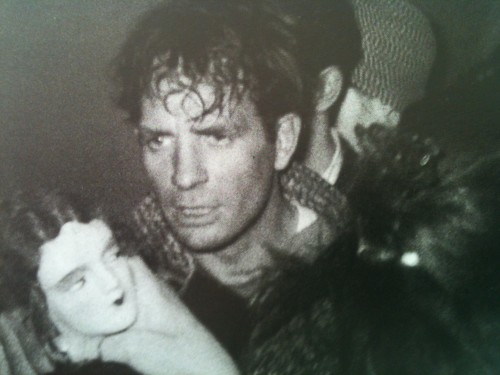25 Points: Hunger
 Hunger
Hunger
by Knut Hamsun
Farrar, Straus and Giroux, 2008
272 pages / $16.00 buy from Amazon
1. This is an article about Robert Bly’s (b. 1926) translation of Hunger by Knut Hamsun (b. 1859). It was published by FSG in 1967.
2. The cover graphic is the word HUNGER stylized as an open mouth with 2 rows of sharp teeth. I bought my copy in January 2013 from a used bookseller in Toronto. The clerk said it was her favorite book, esp this edition because she liked the cover. The design is not credited in the edition notice.
3. Knut Hamsun is clean shaven and wearing a monocle in a photograph taken in 1890, the year Hunger was first published in Norway. In later photographs he is moustachioed and wears glasses. In the last known photographs of Hamsun he wears a large white beard and squints.
4. The first several times I read Hunger by Knut Hamsun was in a hardcover edition translated by George Egerton aka Mary Chavelita Dunne in 1899. This review is not about that translation, nor is it about the 1996 translation by Sverre Lyngstad.
I am descended from Norwegians but know nothing of the language. This article is not as much a review of the translation itself as it is a discussion of the fact of its publication in 1967.
5. The main introductory essay to Bly’s translation is by Isaac Bashevis Singer (b. 1902) noted Jewish-American author and pioneer of modern Yiddish literature.
“Writers who are truly original do not set out to fabricate new forms of expression,” says Singer, “or to invent themes merely for the sake of appearing new. They attain their originality through extraordinary sincerity.”
6. “People do not love alike, neither do they starve alike.” (Singer).
7. Hunger is about a young man with artistic leanings living in Kristiania, Norway. From biographical details about Hamsun we can guess that the story is based on Hamsun’s own experiences and takes place in in 1879-80.
Hunger itself does not offer much in the way of context. It is a first person account of a young man living alone in a city. He appears to have no awareness of anything outside his own need, which is mostly for food. He is starving and desperate, but the private code by which he lives forbids him from taking work that he considers to be below his abilities.
8. His mental state throughout is ostensibly a result of his being hungry, rather than a symptom of mental illness or PTSD for example. He cycles rapidly through extreme moods: hilarity, despondency, optimism, despair, loneliness, social anxiety etc.
9. Doubt is the driving force behind the narrator’s racing thoughts. His doubt tirelessly regenerates itself. Doubt is what drives the desperation and sets its parameters. It is what keeps need always at the centre.
At every moment he is like a reckless gambler who has already placed his bet before realizing the stakes are too high, and then in a panic must cut his losses before waiting to see the outcome.
“He was a man before his time,” says Singer, “His skepticism, or perhaps it could be called pyrrhonism — doubting even the doubts — belonged to a later era. To Hamsun man was nothing but a chain of moods that kept constantly changing, often without a trace of consistency.”
10. “Fictional heroes who are estranged from their environment seldom emerge lifelike,” says Singer, “With most writers, such heroes are mere shadows, or, at best, symbols. But Hamsun is able to portray both the environment and the alienation, the soil and the extirpation. His heroes have roots even though they cannot be seen.”
There is almost no historical or social/political context in Hunger. In most novels of the era that would be seen as a fault. In Hunger it is seen as a strength.
As a reader I only interact with the narrator’s environment as needed. That is because the novel is not about Norway or Europe: it is about being hungry. READ MORE >
September 19th, 2013 / 2:53 pm

